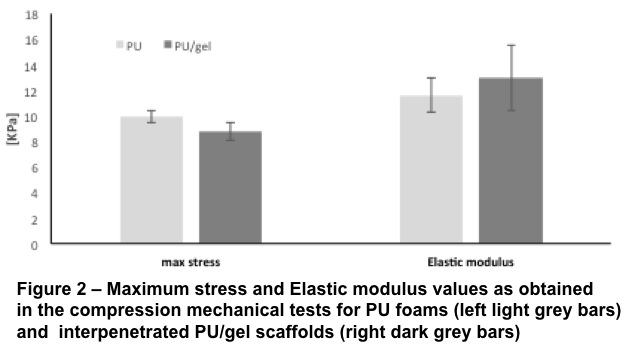Introduction: Adipose tissue (AT) is a connective tissue that can be affected by severe pathologies (breast cancer, lipoatrophy). Strategies aiming to AT regeneration represent a valid alternative approach to clinical strategies (lipofilling, autologous tissue grafting), preventing loss of volume after implantation[1]. We are here proposing the use of an innovative hybrid polyurethane (PU) scaffold interpenetrated with cross-linked gelatin to promote adipose-derived stem cells (ADSCs) differentiation, while providing the adequate structural support.
Materials and Methods: PU foams (PUf) were synthesized by gas foaming in an one-step bulk reaction. The reagents used were: MDI prepolymer (Bayer), an ad hoc polyether polyol mixture, FeAcetylAcetonate as catalyst, and water (2% w/wpolyol) as expanding agent. Gelatin type A (6% w/v) was crosslinked by a Michael-type addition with N,N’-methylene-bysacrylamide[2]. Hybrid scaffolds (PU/gel) were produced by interpenetrating PUf samples with gelatin during the crosslinking reaction, by use of a vacuum chamber, to promote the coating of the internal pores of the PUf. Scaffolds were observed at SEM; compression and frequency sweep tests were performed by DMA. ADSCs were isolated from mice adipose tissue by enzymatic digestion and expanded in DMEM/Ham’s F12 medium. Cells were seeded onto PU-gelatin scaffolds (TCPS wells as control) and cultured in adipogenic medium (0.5 mM isobutylmethylxanthine, 50 lM indomethacin and 0.5 lM dexamethasone). After 3, 6 and 12 days of culture, the number of differentiated cells was counted by Oil Red staining (OR) and cell morphology assessed by SEM.
Results and Discussion: SEM images (Fig.1) showed the presence of the gelatin coating until the inner pores of the PU foam.

PU/gel bulk mechanical properties (Fig.2) were not statistically different from PUf ones, proving the gelatin coating not to influence the mechanical properties.

After 3 and 6 days of culture, the number of OR positive cells into PU/gel vs the total number of seeded cells was close to 50 and 80%, respectively (Fig.3A) and significantly different from the control (20% and 60%), proving the PU/gel to promote a faster adipogenesis. After 12 days, no significant differences were detected between PU/gel and the control, showing 95% of OR positive cells. The presence of mature adipocytes with the typical round morphology was detected at SEM (Fig.3B, left), confirming the ability of PU/gel to support ADSC differentiation. On the contrary, a small percentage of cells resulted positive to OR onto TCPS wells (Fig.3B, right).

Conclusions: PUf were successfully interpenetrated with crosslinked gelatin, thus obtaining a more hydrophilic ECM-mimicking surface. These novel hybrid scaffolds were able to promote ADSCs adhesion and adipogenesis in a very short period (3 days), proving their suitability as valid substrate for AT regeneration.
AC was partially supported by PRIN 2010–2011 (PRIN 20102ZLNJ5_006), financed by the Ministry of Education, University and Research, Italy.
References:
[1] Mojallal A et al, Ann Chir Plast Esthet 2004
[2] MC Tanzi, et al, WO2012164032 A1 Patent